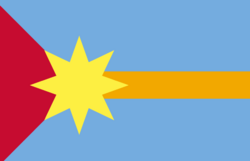Anchwa
Anchwa
| Anchwa | |
|---|---|
 Flag of the Anchwanese Republic | |
| Pronunciation | [anʧwa] |
| Created by | camrionr_ |
| Date | 2023 |
| Setting | Alternate Version of Earth |
| Native to | Anchwan Nation (Thailand, Cambodia and most of the Malay peninsula) |
| Ethnicity | Thai people |
| Native speakers | Around 100 million (2024) |
Austro-Asiatic
| |
Early forms | Proto-Austro-Asiatic
|
Standard form | Central Anchwa |
Dialects |
|
|
| |
| Official status | |
Official language in | Republic of Anchwa |
Recognised minority language in | Laos, Vietnam, Myanmar |
| Regulated by | Department of Anchwanese Language |
| Language codes | |
| CLCR | NCW |
| Glottolog | code for the language Glottolog code for the language name of code glottoGlottolog code for the language Second Glottolog code for the language name of code glotto2 |
| ConWorkShop | code for the language ConWorkShop code for the language |
| IETF | IETF (BCP 47) code for the language |
| BRCL | Brightraven Registry of Constructed Languages code for the language |
caption to appear under map | |
caption to appear under both mapswidth.) | |
Overview
Anchwa is a language spoken in Southeast Asia and West Indochina. It is recognized as the National Language of the Republic of Anchwa. It has two forms, Old Anchwa (or Anchwa rae mai),and modern Anchwa (Anchwa khô mai)It is a historically tonal language that has since lost its tones. Some dialects in the north and east may still remain tonal. Anchwa has a surprisingly high amount of loans from Chinese, Korean, Japanese, and Arabic. Less surprisingly, it has loans from Vietnamese, Khmer and Thai. Malay and Indonesian words have trickled in, but mostly have stayed away from the northern dialects. Malay and Indonesian loans make up about 7% of the Central dialect's words, however, in the Peninsula's dialect, they make up almost 30 percent of the whole vocabulary.